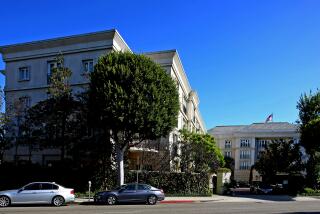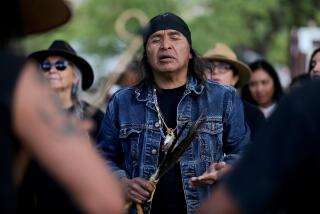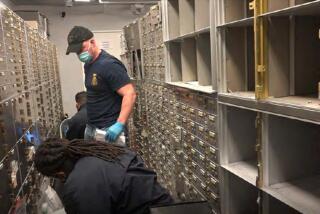After 6 years, ownership of massive emerald may finally be settled
Over the last 61/2 years, nine men, one woman, three corporations and one government have laid claim to the giant emerald that’s been at the center of a protracted ownership dispute in Los Angeles County Superior Court.
On Thursday, Judge Michael Johnson, the second judge to preside over the case, said he finally has determined the owner.
Johnson’s tentative ruling hands victory to a holding company owned by three businessmen, who claimed the emerald became theirs after it was put up as collateral in a $1.3-million deal for diamonds that ultimately fell through.
The company — co-owned by Idaho businessmen Kit Morrison and Todd Armstrong, and Jerry Ferrera of Florida — “has presented evidence establishing clear title to the Bahia Emerald as against all other ownership claims,” Johnson wrote in his decision.
Johnson’s ruling still may not be the end of the legal saga surrounding the emerald; the judge said he was not ruling on any claim the nation of Brazil may have to the gem.
In a 14-page ruling, Johnson chronicled the tortuous history of the jewel after it was discovered in a mine in the Brazilian state of Bahia in 2001 until it landed in his courtroom. Although media reports, including The Times’, have put the stone at 840 pounds, Johnson said in his ruling that it was 751.77 pounds and nearly 3 feet at its tallest point.
The Bahia Emerald, a massive black schist with nine protruding emerald crystals, was shipped from Bahia to Sao Paulo, Brazil; San Jose; New Orleans; South El Monte; and Las Vegas.
During its long journey, the stone was at the center of a number of failed business deals, soured partnerships and unkept promises. During Hurricane Katrina in 2005, the emerald was submerged in floodwaters and inaccessible, causing one transaction to fall through.
It was seized by Los Angeles County sheriff’s detectives in 2008 after a gem dealer reported it stolen from an L.A.-area warehouse. Sheriff’s officials tracked the gem to a Las Vegas vault. Since then, it has remained in sheriff’s custody in an undisclosed location as the legal battle slogged through the courts.
Sheriff’s officials have not allowed access to the jewel in the intervening years. They even refused to let attorneys on the case see it, despite a judge’s order requiring them to produce the emerald, attorneys said. Instead, photographs of the emerald encased in a wooden crate were shown to assure them it was secure.
Since the lawsuit over its ownership was first filed in early 2009, two men’s claims to the emerald were rejected by the courts, and the rest have dropped or settled their cases, leaving only the three men behind the holding company still claiming ownership. Even so, under California law, the remaining group had to prove it had a legitimate claim because property cannot be acquired by default, attorneys said.
“A lot of very strange players showed up in this case,” said attorney Brown Greene, who represented the prevailing group and now owns part of the emerald, having worked on the case on a contingency basis.
Last fall, the government of Brazil tried to intervene and stop the legal proceedings, claiming that the stone was mined illegally and should be returned to its home country. Johnson ruled the case should go forward over Brazil’s objections.
An attorney for the nation has said that the Brazilian government was in talks with U.S. authorities about the return of the emerald.
“This ruling will not stop Brazil’s efforts to recover the Bahia Emerald,” attorney John Nadolenco said Friday. The emerald, he said, was “illegally mined, illegally exported and almost certainly illegally imported.”
At a one-day trial earlier this month, Morrison, one of the three businessmen, took the witness stand to describe the 2008 deal in which he was to purchase a large quantity of uncut diamonds. He paid a $1.3-million advance for the diamonds and was promised the emerald as collateral in the event that the diamonds weren’t delivered, Morrison told the judge.
“Quite frankly, I didn’t know what I would do with the Bahia Emerald,” he said.
“It seems like a very strange transaction,” the judge remarked at the time.
Nonetheless, Johnson found that each person who sold or transferred the emerald to the next, leading up to the diamond deal, had the proper authority to do so. Morrison and his business partners also properly researched the emerald’s provenance and purchased it in “good faith,” the judge wrote.
Objections to the tentative decision can be filed within a 15-day period before the judgment becomes final.
Attorney Andrew Spielberger, who represents Morrison, said that when Morrison first surrendered the emerald to detectives, he thought he’d have it back in a matter of weeks.
“My clients have waited six years, so we’ll wait the 15 days,” Spielberger said.
For news on the courts, follow @vicjkim.
More to Read
Start your day right
Sign up for Essential California for news, features and recommendations from the L.A. Times and beyond in your inbox six days a week.
You may occasionally receive promotional content from the Los Angeles Times.







